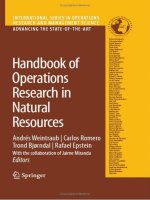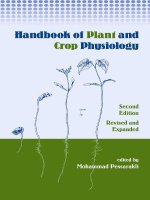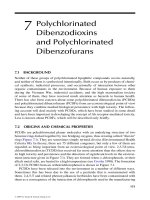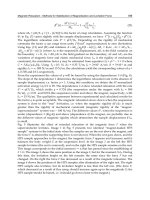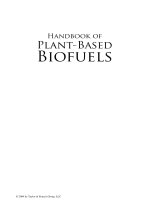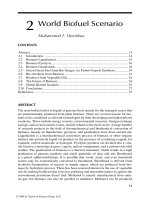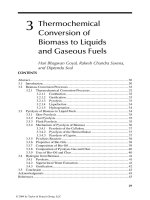Handbook of plant based biofuels - Chapter 7 pdf
Bạn đang xem bản rút gọn của tài liệu. Xem và tải ngay bản đầy đủ của tài liệu tại đây (364.9 KB, 17 trang )
87
7
Bioethanol from
Starchy Biomass
Part I Production of Starch
Saccharifying Enzymes
Subhash U Nair,
Sumitra Ramachandran,
and Ashok Pandey
ABSTRACT
There has been a substantial shift in global perception of the production of ethanol
from plant-based biomass. These could be of starchy or cellulosic (or lignocellulosic)
CONTENTS
Abstract 87
7.1 Introduction 88
7.2 Enzymes Hydrolyzing α-1,4-Glucosidic Linkages 88
7.2.1 Endo-amylases (EC 3.2.1.1) 88
7.2.2 Exo-amylases (β-amylases EC 3.2.1.2) 88
7.3 Enzymes Hydrolyzing α-1,6-Glucosidic Linkages 88
7.3.1 Pullulanases (EC 3.2.1.41) 90
7.3.2 Isoamylases (EC 3.2.1.68) 90
7.4 Transglycosylation to Form α-1,4 and/or α-1,6-Glucosidic Linkages 90
7.4.1 Cyclodextrin Glucotransferase (EC 2.4.1.19; CGTases) 90
7.5 Hydrolysis of Both α-1,4- and α-1,6-Glucosidic Linkages 90
7.5.1 Glucoamylases (EC. 3.2.1.3) 90
7.6 Sources 91
7.7 Production 94
7.7.1 α- and β-Amylases 95
7.7.2 Glucoamylase 96
7.7.3 Pullulanase 96
7.8 Purication 96
References 102
© 2009 by Taylor & Francis Group, LLC
88 Handbook of Plant-Based Biofuels
nature, which requires a step of hydrolysis to produce fermentable sugars which then
can be fermented to ethanol. The hydrolysis of the starchy raw materials can be done
by acids or enzymes, but due to several advantages enzymatic hydrolysis offers, it is
the preferred choice for industrial applications. The enzymes involved in hydrolysis
include α-amylase, β-amylase, glucoamylase, and pullulanase. These enzymes can
be obtained from plant and microbial sources but industrial demand is met through
the latter. This chapter presents a brief description of the sources, applications, and
production of these enzymes.
7.1 INTRODUCTION
The amylases (a term that refers to α-amylase and β-amylase here) can be generally
dened as the enzymes that hydrolyze the O-glycosyl linkage of starch. α-Amylases
are one of the most popular and important forms of the industrial amylases and have
different reaction and product specicities, which include exo- and endo-specicity,
preference for the hydrolysis, or the transglycosylation, α-(1,1), α-(1,4) or α-(1,6)-
glycosidic bond specicity and glucan synthesizing activity. Depending on the type
of cleavage caused on starch, the enzymes belonging to the amylase family are of the
following types (see Figure 7.1; Kuriki and Umanaka 1999).
7.2 ENZYMES HYDROLYZING α-1,4-GLUCOSIDIC LINKAGES
7. 2.1 e
n d o -a m y l a S e S (ec 3.2.1.1)
This group of enzymes known as α-amylases cleave the α-1,4-glucosidic linkages.
These enzymes generally do not cleave the α-1,6-glucosidic linkages. It is the most
widespread enzyme among aerobes and anaerobic microbes. α-Amylases from dif-
ferent sources have been puried and many have been crystallized. These enzymes
are chiey required in the thinning of starch in the liquefaction process in the sugar,
alcohol, and brewing industries.
7.2.2 ex o -a m y l a S e S (β-a m y l a S e S ec 3.2.1.2)
The β-amylases generally occur in plants such as malt, sweet potato, soy bean, etc.,
and also as extracellular enzymes in some aerobic and anaerobic microorganisms.
This enzyme degrades the amylose, amylopectin, and glycogen in an exo-fashion
from the nonreducing ends, by hydrolyzing the alternate glucosidic linkages. It is
incapable of bypassing the α-1,6 linkages and, hence, causes the incomplete hydro-
lysis to form limit dextrins.
7.3 ENZYMES HYDROLYZING α-1,6-GLUCOSIDIC LINKAGES
The debranching enzymes hydrolyze the α-1,6-glycosidic linkages in branched poly-
mers. Two types of direct debranching enzymes, namely pullulanase and isoamylase
are known.
© 2009 by Taylor & Francis Group, LLC
Production of Starch Saccharifying Enzymes 89
Maltotriose, Linear
oligosaccharides
Debranching enzymes
Glucose
CH
2
OH
CH
2
OH
O
O
O
O
H,OH
α-amylase (endo)
Linear oligosaccharides
Maltose and beta limit dextrin
Alpha limit dextrin, linear
oligosaccharides, glucose
and maltose
Cyclodextrin glycosyl
transferase
Cyclodextrin
β-amylase (exo)
CH
2
OH CH
2
OH CH
2
OH
CH
2
OH
CH
2
OH
CH
2
OH CH
2
OH
O
O O
O
O
O
O
O O
4 1 4 1 4 1
O O O
O
CH
2
OH
CH
2
OH
CH
2
OH
CH
2
OH CH
2
OH
4 4 4 1 4 1 1 1
O
O
O
O
O
O
O O O
O
CH
2
OH
6CH
2
CH
2
OH
CH
2
OH CH
2
OH
O
O
O
O
O
O O O
O
CH
2
OH CH
2
OH
O
O
CH
2
OH
O
O O
CH
2
OH
O
CH
2
OH
O
O O
6CH
2
O
CH
2
OH
6CH
2
CH
2
OH
CH
2
OH CH
2
OH
O
O
O
O
O
O O O
O
H,OH
O
O
O
CH
2
OH
O
O
CH
2
OH
O
O
CH
2
OH
O
O
1
CH
2
OH
O
O
1
Isoamylase
Pullulanase-1
Glucoamylase
FIGURE 7.1 Schematic representation of different enzymes belonging to the amylase family.
© 2009 by Taylor & Francis Group, LLC
90 Handbook of Plant-Based Biofuels
7. 3.1 Pu l l u l a n a S e S (ec 3.2.1.41)
The enzymes that hydrolyze certain α-1,6-linkages are classied as pullulanases.
These enzymes are capable of hydrolyzing the α-1,6-linkages in polysaccharides
such as starch, amylopectin, and especially in pullulan to give the trisaccharide
maltotriose. True pullulanases do not hydrolyze the α-1,4-linkages in pullulan. The
pullulanases are different from isoamylase for their ability to degrade the branches
of pullulan.
7. 3. 2 iS o a m y l a S e S (ec 3.2.1.68)
Isoamylase generally occurs in higher plants (the enzyme from such sources
is referred to as R-enzyme) but has also been found in yeast and bacteria. These
enzymes have little or no effect on pullulan, but cleave all the α-1,6-linkages in
amylopectin and glycogen.
7.4 TRANSGLYCOSYLATION TO FORM α-1,4
AND/OR
α-1,6-GLUCOSIDIC LINKAGES
7.4.1 c
y c l o d e x t r i n Gl u c o t r a n S f e r a S e (ec 2.4.1.19; cGta S e S )
This is a unique enzyme capable of converting starch and related substances to cyclodex-
trin (CD). It is a multifunctional enzyme and catalyzes the conversion of the starch into
CD by intramolecular transglycosylation (cyclization) and in the presence of acceptors
it also catalyzes intermolecular transglycosylation (coupling and disproportionation).
7.5 HYDROLYSIS OF BOTH α-1,4- AND
α-1,6-GLUCOSIDIC LINKAGES
7. 5.1 G
l u c o a m y l a S e S (ec. 3.2.1.3)
This class of enzymes, also referred to as amylogucosidases or saccharogenic amy-
lase (1,4-α--glucan glucohydrolase), are capable of cleaving both α-1,6- and α-1,4-
glucosidic linkages. These enzymes remove one glucose unit at a time from the
nonreducing end of the large carbohydrate molecule. Although they are capable of
hydrolyzing certain α-1,6-glucosidic linkages, they hydrolyze the α-1,4-glucosidic
linkages much more rapidly. The microbial glucoamylase is important in the starch
bioprocessing and brewing industry where the hydrolysis of starch is necessary.
These enzymes can convert starch to glucose even in the absence of other enzymes.
There are a few deviations from the above classication, since many enzymes
are reported to show mixed types of the specicity. For example, the α-amylases
weakly catalyze the α-1,4 transglycosylation; the CGTases feebly catalyze the α-1,4
hydrolysis in addition to the main reaction, the α-1,4 transglycosylation. There are
a few α-amylases that catalyze the α-1,6 hydrolysis. Some pullulanases from ther-
mophilic microorganisms have recently been reported to hydrolyze not only α-1,6-
but also α-1,4-glucosidic linkages (Guzman-Maldonado and Paredas-Lopez 1995;
Kuriki and Umanaka 1999).
© 2009 by Taylor & Francis Group, LLC
Production of Starch Saccharifying Enzymes 91
Most starch-converting enzymes belong to the GH-13 family. The α-amylase
family or GH-13 family, is a large enzyme family that constitutes about 20 enzymes.
This family can be further classied into clans, based on the three-dimensional
structure of their catalytic components. Each of the clans may consist of two or
more families with similar three-dimensional structure of their catalytic domain but
with few sequence similarities, since protein structure is conserved to a large extent
by the evolution as compared to the amino acid sequence. The α-amylase family
(GH-13) belongs to the eighth clan among the fourteen clans described (Reddy, Nim-
magadda, and Rao 2003). An enzyme should have the following characteristics to be
included in this family: it should have specicity for α-1,4- or 1,6-glucosidic link-
ages and be capable of hydrolyzing them to produce mono- or oligosaccharides, or
capable of transglycosylations to form α-glucosidic linkages. They should have Asp,
Glu, and Asp residues as the catalytic sites, corresponding to the Asp 206, Glu 230,
and Asp 297 of Taka amylase A and should possess four highly conserved regions
in their primary structures consisting of catalytic and important substrate-binding
sites. α(ß/α)
8
; the TIM barrel catalytic domain is also a required feature (Kuriki and
Umanaka 1999, Henrissat 1991).
7.6 SOURCES
The starch saccharifying enzymes play a dominant role in carbohydrate metabolism
and are produced by many plants and animals. They are also produced by several
microorganisms, which are the preferred sources for commercial production. These
enzymes are either cell bound, intracellular, or extracellular. From a commercial
point of view, extracellular enzymes are preferred and since the applications of these
enzymes are usually at temperatures higher than 50°C, it is always advantageous to
isolate enzymes that are thermostable. The major microbial sources of the thermo-
stable α-amylases are Bacillus sp, especially B. subtilis, B. stearothermophilus, B.
licheniformis, and B. amyloliquefaciens, and are widely used for the commercial
production of the enzyme for various applications (Bertoldo and Antranikian 2001).
However, for industrial applications, B. licheniformis (Thermamyl) and B. amyloliq-
uefaciens are commonly employed. Equally important are the lamentous fungi,
predominantly from the genus Aspergillus, which are widely used for the production
of these enzymes, especially glucoamylase (Pandey et al. 2000a; Gupta et al. 2003;
Sivaramakrishnan et al. 2006).
However, in comparison to the ubiquitous presence of the α-amylases, β-amylases
are produced by relatively fewer organisms. As regards glucoamylase, the bacterial
sources do not provide sufcient glucoamylase for commercial needs. Currently,
glucoamylase is produced mainly by the solid-state or submerged fermentation of
many molds and bacteria, mainly from Aspergillus niger, A. oryzae, A. phoenicis, A.
candidus, A. awamori, Rhizopus delemar, Mucor rouxianus, etc.
The debranching enzymes R-enzymes or pullulanases are reported from several
plant, animal, and microbial sources. Pullulanase was rst discovered in Klebsiella
species. In the industry, the thermostable and acidophilic pullulanases are produced
from Bacillus acidopullulyticus. The pullulanases from
Thermococcus sp., T. litora-
lis,
Pyrococcus furiosus, and P. woesei have been described as type II as they cleave
© 2009 by Taylor & Francis Group, LLC
92 Handbook of Plant-Based Biofuels
both the α-1,4- and α-1,6-glucosidic bonds in starch and related polysaccharides.
Neopullulanase, which hydrolyzes pullulan to panose (6-α--glucosylmaltose) by
hydrolyzing its α-(1,4)-glucosidic linkages, are found in Bacillus, Micrococcus, Ther-
moactinomycetes, and Listeria species. The isopullulanases (IPU) hydrolyze α-(1,4)
glucosidic linkages of pullulan to produce isopanose (6-O-α-maltosyl-glucose). Few
strains of fungi produce these types of pullulanases, for example, Aspergillus niger
and Arthrobacter sp. The IPU does not attack the starch or dextran. Table 7.1 sum-
marizes different bacterial and fungal sources of amylase, glucoamylase, and pul-
lulanase (Doman-Pytka and Bardowski 2004).
TABLE 7.1
Microbial Sources of Starch Saccharifying Enzymes
α
-Amylase β-Amylase Glucoamylase Pullulanase
Aeromonas caviae Aspergillus terreus Acremonium zonatum Aerobacter aerogenes
Acinetobacter Bacillus cereus Amylomyces rouxii Anaerobranca
gottschalkii
Alicyclobacillus
acidocaldarius
B. circulans Arxula adeninivorans Bacillus
acidopullulyticus
Alteromonas
haloplanetis
B. megatarium Aspergillus sp. Bacillus
stearothermophilus
Archaeobacterium
pyrococcus woesei
B. polymyxa A. awamori Bacillus cereus
Aspergillus sp. Brettanomyces
naardensis
A. candidus Bacillus circulans
A. awamori C. thermocellum A. foetidus Bacillus avocaldarius
A. avus Clostridium
thermosulfurogenes
A. niger Bacillus macerans
A. fumigatus Corynascus sepedonium A. oryzae Bacillus naganoensis
A. kawachi Debaromyces sp. A. phoenicus Bacteroides
thetaiotaomicron
A. niger Emericella nidulans 45 A. saitri Clostridium
thermohydrosulfuricum
A. oryzae E. nidulans MNU 82 A. terreus Clostridium
thermosaccharolyticum
A. usanii Malbranchea sulfurea Bacillus rmus/lentus Desulfurococcus
mucosus
Bacillus sp. Pafa rhodozyma B. stearothermophillus Fervidobacterium
pennavorans
B. acidocoldarius Pichia anomala Candida famata Klebsiella aerogenes
B. amyloliquefaciens P. holestii Cephalosporium
charticola
Klebsiella pneumoniae
B. brevis Pseudomonas sp. Chalara paradoxa Klebsiella planticola
B. circulans Rhizopus japonicus Clostridium sp. Klebsiella oxytica
B. coagulans Saccharomyces sp. C. acetobutylicum Micrococcus sp.
© 2009 by Taylor & Francis Group, LLC
Production of Starch Saccharifying Enzymes 93
TABLE 7.1
Microbial Sources of Starch Saccharifying Enzymes
α
-Amylase β-Amylase Glucoamylase Pullulanase
Bacillus avothermus Sacchoromyces
cerevisiae
Clostridium
thermohydrosulfuricum
Pyrococcus woesei
B. globisporus Syncephalastrum
racemosum RR96
C.
thermosaccharolyticum
Rhodothermus marinus
B. licheniformis Streptomyces sp. C. thermosulfurogenes Streptococcus mitis
B. megaterium Thermomyces
lanuginosus
Cladosporium resinae Streptococcus
pneumoniae
B. stearothermophilus Trichosporon beigelii Coniophora cerebella Streptococcus pyogenes
B. subtilis Endomyces sp. Thermoactinomyces
thalpophilus
B. halmapalus Flavobacterium sp. Thermoanaerobacter
ethanolicus
Clostridium
acetobutylicum
Fusidium sp. Thermoanaerobacter
nnii
C. butricum Halobacter sodamense Thermoanaerobacter
saccharolyticum
C.
thermohydrosulfuricum
Humicola lanuginosa Thermoanaerobacter
thermohydrosulfuricus
C. thermosulfurogenes Lactobacillus brevis Thermoanaerobacter
thermosulfurogenes
Filobasidium
capsuligenum
Magnaporthe grisea Thermoanaerobium sp.
Halobacterium halobium Mucor rouxianus Thermococcus
hydrothermalis
H. salinarium Neurospora crassa Thermotoga maritima
Humicola insolens Penicillium italicum Thermus aquaticus
H. lanuginosa P. oxalicum Thermus caldophilus
H. stellata Piricularia oryzae Thermus thermophilus
Lactobacillus brevis Rhizoctania solani
Malbrachea pulchella
var. sulfurea
Rhizopus sp.
Micrococcus luteus R. delemar
M. varians R. javanicus
Micromonospora
vulgaris
R. niveus
Mucor pusillus R. oligospora
Myceliophthora
thermophila
R. oryzae
Myxococcus coralloides Sachharomyces
diastaticus
Nocardia asteroides Thermomyces
lanuginosus
© 2009 by Taylor & Francis Group, LLC
94 Handbook of Plant-Based Biofuels
7.7 PRODUCTION
The starch saccharifying enzymes can be produced by submerged fermentation
(SmF) and solid-state fermentation (SSF). For ease of handling and greater control
of the physicochemical factors such as temperature and pH, submerged fermentation
traditionally has been the preferred method of production. However, SSF has been
considered superior in several aspects to SmF (Pandey 1992, 1994, 2003). It is cost
effective due to the use of simple fermentation media comprised mainly of agro-
industrial residues, uses little water, which consequently releases negligible or
considerably less efuent, thus reducing pollution. The SSF processes are simple,
provide easy aeration, use low volume equipment (lower cost), and are yet effec-
tive by providing high product titers (concentrated products) (Pandey et al. 2004).
Both natural and synthetic media are used for the production of amylolytic enzymes.
Because the synthetic components are expensive, alternative cheaper sources such
as agricultural by-products for the reduction of the cost of the medium are useful. In
general, the production of these enzymes is affected by a variety of physicochemical
factors, notably the composition and pH of the growth medium, inoculum size and
age, temperature, aeration and agitation, and the carbon and nitrogen sources.
TABLE 7.1
Microbial Sources of Starch Saccharifying Enzymes
α
-Amylase β-Amylase Glucoamylase Pullulanase
Penicillium brunneum Trichoderma reesei
Pseudomonsa stutzeri T. viride
Pyrococcus woesei
Rhizopus sp.
Scytalidium sp.
Talaromyces
thermophilus
Thermus sp.
Thermoactinomyces sp.
T. vulgaricus
Thermococcus profundus
Thermoascus
aurantracus
Thermomonospora
viridis
Thermonospora curvata
T. vulgaris
Thermomyces
lanuginosus
Thermotoga maritime
Torula thermophila
© 2009 by Taylor & Francis Group, LLC
Production of Starch Saccharifying Enzymes 95
7.7.1 α- a n d β-am y l a S e S
To counter the increasing commercial need for the amylases, continuous efforts are
underway to reduce the cost of production of α-amylase. Employing SSF to uti-
lize agricultural polymeric wastes is one of the most signicant ways of reducing
the cost of amylase production. These wastes provide both support and nutrition to
the microbes, and include wheat bran, spent brewing grain, maize bran, rice bran,
rice husk, coconut oil cake, mustard oil cake, corn bran, amaranths grains, gram
bran, palm oil cake, sunower meal, pearl millet bran, soy meal, etc. (Pandey et
al. 2000a; Ramachandran et al. 2004a, 2004b;, Bogar et al. 2002; Francis et al.
2002, 2003; Satyanarayana et al. 2004; Sivaramakrishnan et al. 2006). Among these,
wheat bran is generally considered the most suitable substrate. Filamentous fungi
are generally reported to produce high titers of extracellular enzymes, and several
strains of Aspergillus sp. and Rhizopus sp. are commonly used. A strain of Thermo-
myces lanuginosus, a thermophilic fungus, was reported as an excellent producer
of α-amylase (Jensen and Olsen 1992). The α-amylase from Pycnoporus sanguine
by cultivation in SSF resulted in fourfold higher enzyme production than in SmF.
Several yeast strains such as Saccharomycopsis capsularia and Cryptococcus sp.
are also employed in α-amylase production using SSF (Satyanarayana et al. 2004;
Sivaramakrishnan et al. 2006).
The industrial submerged fermentation process is generally carried out in batch
or in fed-batch mode. Simple and cheap media containing corn steep liquor and soy-
bean meal or whey-based media offer benets of cost reduction and higher yields.
The enzyme production is induced by the presence of some natural materials such
as beet pulp, corn cob, rice husk, wheat bran, and wheat straw in the production
medium and is generally affected by the pattern of growth of the microorganism and
any morphological changes (in case of fungus). The cell growth and α-amylase pro-
duction patterns are generally similar regardless of the limiting nutrient, suggesting
that there exists stationary phase gene control of α-amylase production as opposed
to a direct response to nutrient limitation. The dissolved oxygen tension is an impera-
tive factor for α-amylase production and higher aeration rates improve the yields.
Bacillus sp. is the most preferred and important source for the production for most
amylolytic enzymes. Most applications of α-amylase require it to be thermotolerant,
which is generally obtained from B. licheniformis; thermostable fungal α-amylase
is obtained from A. niger and A. oryzae.
As compared to α-amylase, not much is known about the production of
β-amylase using microorganisms. Some microorganisms that produce β-amylase
include B. polymyxa, B. cereus, B. megatarium, Streptomyces sp., Pseudomonas sp.,
and Rhizopus japonicus (Crueger and Crueger 1989; Pandey et al. 2000a).
The technique of immobilization has also been employed for the production of
the amylases (Pandey et al. 2000b). Various immobilization techniques can be uti-
lized for α-amylase production, such as entrapment in gels using calcium alginate,
kappa-carrageenan, agar and their combinations with polyethylene oxide, adsorption
on cut disks of polymerized polyethylene oxide, and xation on formaldehyde acti-
vated acrylonitrile-acrylamide membranes.
© 2009 by Taylor & Francis Group, LLC
96 Handbook of Plant-Based Biofuels
7.7. 2 Gl u c o a m y l a S e
Most of the commercial production of glucoamylase (GA) is carried out by sub-
merged fermentation. The production is generally characterized by the simultaneous
production of small quantities of other enzymes, referred to as associated activities.
These include transglucosidase, which, however, is an undesirable phenomenon and
should be controlled. The production of α-amylase in very small quantities is con-
sidered desirable as it acts on the starch to catalyze the formation of saccharides of
lower molecular weight, which are broken down to dextrose with relative ease by
the glucoamylase. However, larger amounts of α-amylase may be detrimental to the
production of dextrose as it produces saccharides, which may polymerize to unfer-
mentable dextrose polymers by transglucosidase (Pandey 1995; Pandey et al. 2000a;
Soccol et al. 2004; Sandhya and Pandey 2005).
The fungal strains of Aspergillus and Rhizopus are the main sources of the glu-
coamylase, although bacterial cultures such as Lactobacillus brevis and yeasts can
also be used. The commercial production of GA is carried out by SmF as well as
SSF using fungal strains and strains of A. awamori are frequently employed. Several
agro-industrial residues, in combination and individually, imparted different pat-
terns of GA induction in Aspergillus. In SSF, particle size of the substrate, moisture
content, and water activity inuence GA production (Pandey and Radhakrishnan
1992, 1993; Selvakumar, Ashakumary, and Pandey 1998). The type of bioreactor
used, such as asks, trays, rotary reactors, and columns (vertical and horizontal),
inuence the production of glucoamylase. SSF often yields higher GA titers than
SmF (Pandey et al. 1995).
The technique of immobilization is also widely employed in the production of
the GA. Strains of A. niger, Candida sp. and Endymycopsis sp. have been used for
this purpose (Pandey et al. 2000b, Sandhya and Pandey 2005).
7.7.3 Pu l l u l a n a S e
The pullulanases are either cell bound, intracellular, or extracellular. The enzyme
can be produced by different microorganisms. The selection of an appropriate car-
bon source is critical in pullulanase production, since the enzyme production is con-
trolled by substrate induction and catabolite repression. Most saccharides, such as
soluble starch, potato starch, amylopectin, potato dextrin, maltodextrin, and maltose,
induce varying levels of pullulanase production. This could be attributed to the pres-
ence of α-(1,6) linkages, present in complex polysaccharides, that can induce pro-
duction of pullulanase. Soluble starch is a good source of carbon for the production
of pullulanase, since it can induce the release of the enzyme in the medium (Nair
2006; Nair, Singhal, and Kamat 2006, 2007). Several other starches, dextrins or
maltosaccharides, polypeptone, yeast extract, manganese also induce the production
of pullulanase.
7.8 PURIFICATION
Conventional techniques for the purication of amylases involve several steps, which
include centrifugation of the culture to separate the solid media followed by selec-
© 2009 by Taylor & Francis Group, LLC
Production of Starch Saccharifying Enzymes 97
tive concentration of the supernatant usually by ultraltration or precipitation by
ammonium sulfate or ethanol cold; the crude enzyme is then subjected to different
chromatographic techniques such as afnity, hydrophobic, or ion exchange chroma-
tography and gel ltration. Table 7.2A summarizes some of the purication strate-
gies employed in amylase purication from various microorganism (Pandey et al.
2000a; Satyanarayana et al. 2004; Patel et al. 2005). The bacterial α-amylases gen-
erally show higher temperature optima than the fungal α-amylases, which could
be between 45 and 115°C in the former and around 55°C in the latter. Most of the
α-amylases from the Bacillus sp. possess optimal activity around 60 to 70°C. Simi-
larly, they are active in a wide range of pH, generally close to neutrality or on the
alkaline side (Table 7.2A).
Several modied methods can also be used for the purication of α-amylases. The
enzyme from an archaebacterium Thermococcus profundus was puried to homo-
geneity by ammonium sulfate precipitation, DEAE-Toyopearl chromatography, gel
ltration on Superdex 200 HR and its thermostability was enhanced using Ca
2+
ions.
The α-amylase from Thermus sp. was puried by ion-exchange chromatography
and also by afnity adsorption on starch granules; the enzyme from a thermophilic
and photosynthetic strain of Chloroexux aurantiacus
was puried to homogene-
ity by means of ultraltration, ammonium sulfate fractionation, DEAE-cellulose,
hydroxyapatite, and high-performance liquid chromatography (HPLC). This enzyme
was stable at alkaline pH up to 12 and high temperatures up to 55°C and produced
TABLE 7.2A
Biochemical Characteristics of α-Amylase
Microorganism
Optimum
Temperature
(°C) Optimum pH
Molecular
Mass
(KDa)
K
m
(mg/ml)
Bacillus coagulans 70 6–7 66 1.53
B. stearothermophilus 55–70 4.6–5.1 53 1.0
B. subitilis 60–65 6.8 55 –
B. amyloliquefaciens 65 5–9 – 2.63
B. circulans 60 8.0 76 0.65
B. thermoamyloliquefaciens 70 5.6 78 0.21
B. brevis 80 5–9 58 0.8
Escherichia coli 50–70 6.5–7.0 48 –
Lactobacillus plantarum 65 3.0–8.0 50 2.38
Pyrococcus furiosus 115 5.6 48 –
Aspergillus oryzae 50 4.0 54 –
A. avus 60 6.0 52.5 .013%
A. awamori 55 5 54 1.0
A. niger 50 5.0 – –
A. fumigatus 55 6.0 – –
A. foetidus 45 5.0 41.50 2.19
Thermomyces lanuginosus 80 4.0 61 0.68
Adapted from Satyanarayana et al. (2004).
© 2009 by Taylor & Francis Group, LLC
98 Handbook of Plant-Based Biofuels
maltotriose and maltotetraose from starch (Table 7.2A). Amylases from B. licheni-
formis were puried by enhanced two-phase separation in a PEG-Dextran system,
followed by gel ltration and ion-exchange chromatography; B. subtilis amylase
gene was cloned into a plasmid and transferred to Escherichia coli. The α-amylase
so produced was puried to homogeneity. Its molecular weight (48,000 Da) was
lower than the molecular weight calculated from the derived amino acid sequences
of the B. subtilis complete α-amylase (57,700 Da). The α-amylase produced by the
recombinant cells was puried by specic elution from the anti-peptide antibodies
corresponding to the C-terminal region of target α-amylase, and then specically
eluted by the eluent containing low concentration of the antigen peptide used for
immunization (Pandey et al. 2000a; Satyanarayana et al. 2004).
Some other methods adopted for the purication of α-amylase include autofocus-
ing the enzyme produced by B. subtilis, followed by gel ltration and ion-exchange
chromatography; sequential steps of amylopectin afnity chromatography, DEAE-
ion-exchange chromatography, and Sephacryl S-200 HR gel ltration for an A.
oryzae α-amylase; anion exchange (DEAE-cellulose) and afnity (α-cyclodextrin-
Sepharose) chromatography for α-amylase from A. fumigatus; ammonium sulfate
treatment, afnity binding on cross-linked starch, and DEAE-Biogel A chromatog-
raphy for α-amylase from the yeast Lipomyces kononenkoae, etc. (Pandey et al.
2000a; Satyanarayana et al. 2004).
The purication of β-amylase is also done generally in the same way as that of
α-amylase. A β-amylase from Hendersonula toruloidea was separated by ammonium
sulfate fractionation, ion-exchange chromatography on DEAE-cellulose, and gel ltra-
tion on Sephadex G-75. An extracellular β-amylase from a new isolate of B. polymyxa
was puried by adsorption on raw corn starch to 22.5-fold. A thermostable β-amylase
was puried with ammonium sulfate, DEAE-cellulose column chromatography, and
gel ltration using Sephadex G-200 (Reddy, Swamy, and Seenayya 1998).
The purication and characterization of the GA also follows generally the con-
ventional methods. Table
7.2B cites a few such examples. The enzyme from different
sources shows varied properties; for example, two to six isoforms can exist, with
pH and temperature optima between 4.0 and 6.2 and 50 and 60
o
C, respectively, and
molecular weight of 34 to 141 kDa. It may contain a protein moiety as well, generally
a glycoprotein, and the carbohydrate content varies. For example, the GA puried
to homogeneity from the anaerobic thermophilic bacterium Clostridium thermosac-
charolyticum was made of a single subunit with a molecular weight of 75 kDa. The
GA from A. niger contained four different forms and was puried to 32.4-fold with
a nal specic activity of 49.25 U/mg protein.
Two forms of the GA, homogeneous
in nature, were puried from Monascus kaoang nov. sp. F-I, which exhibited pH
optima at 4.5 and 4.7. A commercial preparation of the GA from A. niger showed six
different forms of GA, having apparently different molecular weights and optimum
pH. Another two forms of the GA from A. niger showed the molecular weight of GA
I as 99,000 and that of GA II as 112,000. Both forms of the GA were glycoenzymes
and showed identical amino acid composition but differed in carbohydrate content.
The GA of Paecifomyces varioti AHU 9417 was puried by precipitation with eth-
anol, chromatography on DEAE-Sepharose CL-6B, gel ltration, and preparative
disc electrophoresis. The GA from Schizophyllum commune was puried by ammo-
© 2009 by Taylor & Francis Group, LLC
Production of Starch Saccharifying Enzymes 99
nium sulfate precipitation, acid-clay treatment, and Sephadex G-100 gel ltration.
Two kinds of GA were obtained by fractionation of Rhizopus sp.; one has a strong
debranching activity while the other has a weak debranching activity. Three kinds
of GA were reported from Rhizopus sp., Gluc l, Gluc 2, and Gluc 3, which showed
similar pH optima and their molecular weight was estimated to be 74,000, 58,600,
and 61,400, respectively (Sandhya and Pandey 2005).
The purication and characterization of the pullulanases produced from micro-
bial sources has traditionally followed conventional methods as for alpha-amylase
and glucoamylase, that is, precipitation, ion-exchange chromatography, and gel l-
tration, although hydrophobic interaction and afnity-based chromatography can
also be used. Table 7.2C lists the different methods of purication of pullulanase
from various microbial sources. It can be observed that most of the purication pro-
cesses involve the multistep sequences of the chromatographic methods, which are
expensive and time consuming. In most cases, these are coupled with a lower recov-
ery percentage. A critical overview shows that no particular method or sequence of
methods should be followed to purify pullulanase. Purication using afnity chro-
matography usually involves maltotriose, pullulan sepharose, octyl sepharose, and
schardinger dextrin. Monoclonal antibodies for specic selection of pullulanase were
also described (Enevoldsen, Reimann, and Hansen 1977). These methods describe
TABLE 7.2B
Biochemical Characteristics of β-Glucoamylase
Microorganism
Nature of
Protein
Carbohydrate
Content,
%
Molecular
Mass (kDa)
Optimum
pH
Optimum
Temperature
(°C)
Neosartorya scheri – – 34 4.0–4.4 55–60
T. lanuginosus Glycoprotein 10–12 57 – 70
T. lanuginosus Glycoprotein 3.3 75 4.4–5.6 70
R. oryzae – – 67 4.8 60
A. terreus – – 70 5.0 60
Mucor rouxianus – – 49, 59 4.7 55
A. saitri Glycoprotein 18 90 4.5 50
A. niger – – – 4.5 50
Acremonium sp. – – 22, 39 5.5 55
Aspergillus fumigatus Glycoprotein 23 42 4.5–5.5 65
A. niger Glycoprotein 16 112, 104 4.4 60
Clostridium sp. – – 4, 61 5.0 70
C.
thermosaccharolyticum
– – 75 4.5 65
Thermococcus
hydrothermalis
– – 77 5.5 95
Thermoplasma
acidophilum
110 2.0 95
Neurospora crassa Glycoprotein 5.1 141, 95 5.0–5.4 60
Saccharomycopsis
buligera
– – 82 5.0–6.2 40-50
62
© 2009 by Taylor & Francis Group, LLC
100 Handbook of Plant-Based Biofuels
TABLE 7.2C
Biochemical Characteristics of Pullulanases
Organism Optimum pH
Optimum
Temperature (°C) pH Stability
Temperature
Stability (°C) No. of Amino Acids Mol. Weight (Da)
Aerobacter aerogenes 6 50 4.5–12 50 – –
Anaerobranca gottschalkii 8 70 70 865 98,973
Bacillus acidopullulyticus 5 65 4–8.5 55 – –
Bacillus cereus 6 50 5–9 50 853 97,502
Bacillus circulans 7 50 5–8 50 – –
Bacillus avocaldarius – – – – 475 53,875
Bacteroides thetaiotaomicron 6.5 – – – – 75,000
Bacillus macerans – 55 – 50 – –
Caldicellulosiruptor saccharolyticus – – – – 825 95,700
Clostridium thermohydrosulfuricum 5.5 60 3–5 85 – –
Clostridium thermosaccharolyticum 5 90 4.5–10.5 90 – –
Desulfurococcus mucosus 5 85 – 90 – –
Fervidobacterium pennavorans 6 85 – 90 –
Bacillus stearothermophilus 6 60 6–8.5 50 – 62,000
Klebsiella aerogenes 6 60 3–11 55 1,096 119,336
Klebsiella pneumoniae – – 3–11 55 1,090 118,098
Klebsiella oxytoca – – – – – 11,600
Micrococcus sp. 8 50 – – – –
Pyrococcus woesei 6 100 – 100 404 46,875
Rhodothermus marinus – 80 – 85 – –
Streptococcus pneumoniae – – – – 759 86,517
Streptococcus pyogenes – – – – 1,165 128,898
© 2009 by Taylor & Francis Group, LLC
Production of Starch Saccharifying Enzymes 101
Thermoactinomyces thalpophilus 7 70 – 80 – –
Thermoanaerobacter ethanolicus 5 80 5–5.5 75 1,481 166,363
Thermoanaerobacter nnii 5 90 – – – –
Thermoanaerobium sp. 5.5 – 3.5–8 80 – –
Thermobacteroides acetoethylicus 5 90 – – – –
Thermoanaerobacter saccharolyticum – – – – 1,279 142,431
Thermoanaerobacter
thermohydrosulfuricus
– – – – 113 13,763
Thermus aquaticus 6.5 – – – – –
Thermus caldophilus 5.5 75 – 95 – –
Thermus thermophilus – 70 – 80 416 47,041
Thermococcus aggregans 6.5 95 – – – –
Thermotoga maritime – – – – 843 96,262
Adapted from Nair (2006).
© 2009 by Taylor & Francis Group, LLC
102 Handbook of Plant-Based Biofuels
one-step purication of pullulanase and amylases from standard preparation of the
enzyme. Techniques like macroafnity ligand facilitate three-phase partitioning for
the pullulanase and glucoamylase purication with alginates (Nair, Singhal, and
Kamat 2006, 2007).
REFERENCES
Bertoldo, C. and G. Antranikian. 2001. Amylolytic enzymes from hyperthermophiles. Hyper-
thermophilic Enzymes 330: 269–289.
Bogar, B., G. Szakacs, R. P. Tengerdy, J. C. Linden, and A. Pandey. 2002. Production of alpha
amylase with Aspergillus oryzae on spent brewing grains by solid-state fermentation.
Applied Biochemistry and Biotechnology 102-103: 453–463.
Crueger, W. and A. Crueger. 1989. Industrial Microbiology, 2nd ed. Sunderland, MA: Sinauer
Associates.
Doman-Pytka, M. and J. Bardowski. 2004. Pullulan degrading enzymes of bacterial origin.
Critical Reviews in Microbiology 30: 107–121.
Enevoldsen, B., L. Reimann, N. L. Hansen. 1977. Biospecic afnity chromatography of pul-
lulanase. FEBS Letters. 79(1): 121–124.
Francis, F., A. Sabu, K. M. Nampoothiri, G. Szakacs, and A. Pandey. 2002. Synthesis of
alpha-amylase by Aspergillus oryzae in solid-state fermentation. Journal of Basic
Microbiology 42(3): 322–326.
Francis, F., A. Sabu, K. M. Nampoothiri, S. Ramachandran, S. Ghosh, G. Szakacs, and A.
Pandey. 2003. Use of response surface methodology for optimising process parameters
for the production of alpha amylase by Aspergillus oryzae. Biochemical Engineering
Journal 15: 107–115
Gupta, R., P. Gigras, H. Mohapatra, V. K. Goswami, and B. Chauhan. 2003., Microbial amy-
lases: A biotechnological perspective. Process Biochemistry 38: 1599–1616.
Guzman-Maldonado, M. and O. Paredas-Lopez. 1995. Amylolytic enzymes and products
derived from starch: A review. Critical Reviews in Food Science and Nutrition 35(5):
373–403.
Henrissat, B. 1991. A classication of glycosyl hydrolases based on amino acid sequence
similarities. Biochemical Journal 280(2): 309–316.
Jensen, B., and J. Olsen. 1992. Physicochemical properties of a puried α-amylase from the
termophilic fungus Thermomyces lanuginosus. Enzyme and Microbial Technology. 14:
112–116.
Kuriki, T. and T. Umanaka. 1999. The concept of the α-amylase family: Structural similarity
and common catalytic mechanism. Journal of Bioscience and Bioengineering 87(5):
557–565.
Nair, S. U. 2006. Studies on microbial pullulanase. PhD thesis, University of Mumbai, Mum-
bai, India.
Nair, S. U., R. S. Singhal, and M. Y. Kamat. 2006. Enhanced production of pullulanase-type
1 using new isolate of Bacillus cereus FDTA 13 and its mutant. Food Technology and
Biotechnology 44(2): 275–282.
Nair, S.U., R. S. Singhal, and M. Y. Kamat. 2007. Induction of pullulanase production in
Bacillus cereus FDTA-13. Bioresource Technology 98(4): 856–859.
Pandey, A. 1992. Recent developments in solid-state fermentation. Process Biochemistry 27:
109–117.
Pandey, A. 1994. Solid-state fermentation: An overview. In Solid-State Fermentation, ed. A.
Pandey, 3–10. New Delhi, India: Wiley Eastern.
Pandey, A. 1995. Glucoamylase research: An overview. Starch/Starke 47(11): 439–445.
Pandey, A. 2003. Solid-state fermentation. Biochemical Engineering Journal 13: 81–84.
© 2009 by Taylor & Francis Group, LLC
Production of Starch Saccharifying Enzymes 103
Pandey, A. and S. Radhakrishnan. 1992. Packed bed column bioreactor for enzyme produc-
tion. Enzyme and Microbial Technology 14: 486–488.
Pandey, A. and S. Radhakrishnan. 1993. The production of glucoamylase by Aspergillus
niger NCIM 1245. Process Biochemistry 28: 305–309.
Pandey, A., L. Ashakumary, P. Selvakumar, and K. S. Vijaylakshmi. 1995. Effect of yeast
extract on glucoamylase synthesis by Aspergillus niger in solid-state fermentation.
Indian Journal of Microbiology 35: 335–338.
Pandey, A., P. Nigam, C. R. Soccol, V. T. Soccol, D. Singh, and R. Mohan. 2000a. Advances
in microbial amylases. Biotechnology and Applied Biochemistry 31: 135–152.
Pandey, A., C. R. Soccol, and V. T. Soccol. 2000b. Biopotential of immobilized amylases.
Indian Journal of Microbiology 40(1): 1–14.
Pandey, A., F. Francis, A. Sabu, and C. R. Soccol. 2004. General aspects of solid-state fermen-
tation. In Concise Encyclopedia of Bioresource Technology, ed. A. Pandey, 702–708.
New York: Haworth Press.
Patel, A. K., K. M. Nampoothiri, S. Ramachandran, G. Szakacs, and A. Pandey. 2005. Par-
tial purication and characterization of alpha amylase produced by Aspergillus oryzae
using spent-brewing grains. Indian Journal of Biotechnology 4(3): 336–341.
Ramachandran, S., A. K. Patel, K. M. Nampoothiri, C. Sandhya, G. Szakacs, C. R. Soccol,
and A. Pandey. 2004a. Alpha amylase from a fungal culture grown on oil cakes and its
properties. Brazilian Archives of Biology and Technology 47(2): 309–318.
Ramachandran, S., A. K. Patel, K. M. Nampoothiri, F. Francis, V. Nagy, G. Szakacs, and A.
Pandey. 2004b. Coconut oil cake: A potential raw material for the production of alpha
amylase. Bioresource Technology 93(2): 169–174
Reddy, N. S., A. Nimmagadda, and K. R. S. S. Rao. 2003. An overview of the microbial
α-amylase family. African Journal of Biotechnology 2(12): 645–648.
Reddy, P. R. M., M. Y. Swamy, and G. Seenayya. 1998. Purication and characterization of
thermostable β-amylase and pullulanase from high yielding clostridium thermosulfu-
rogenesis. World Journal of Microbiology and Biotechnology 14: 89–94.
Sandhya, C. and A. Pandey. 2005. Microbial glucoamylase. In Microbial Diversity, ed. T.
Satyanarayana and B. N. Johry, 679–694. New Delhi: IK International Publishers.
Satyanarayana, T., Uma Maheswar, J. L. Rao, and M. Ezhilvannan. 2004. -Amylases. In
Enzyme Technology, ed. A. Pandey, C. Webb, C. R. Soccol, and C. Larroche, 221–238.
New Delhi: Asiatech Publishers.
Selvakumar, P., L. Ashakumary, and A. Pandey. 1998. Biosynthesis of glucoamylase by
Aspergillus niger in solid-state fermentation using tea waste as the basis of a solid sub-
strate. Bioresource Technology 65: 83–85.
Sivaramakrishnan, S., D. Gangadharan, K. M. Napoothiri, C. R. Soccol, and A. Pandey.
2006. Alpha amylase from microbial sources: An overview on recent developments.
Food Technology and Biotechnology 44(2): 173–184.
Soccol, C. R., P. J. Rojan, A. K. Patel, A. L. Woiciechowski, L. P. S. Vandenberghe, and A.
Pandey. 2004. Glucoamylase. In Enzyme Technology, ed. A. Pandey, C. Webb, C. R.
Soccol, and C. Larroche, 221–238. New Delhi: Asiatech Publishers.
© 2009 by Taylor & Francis Group, LLC

